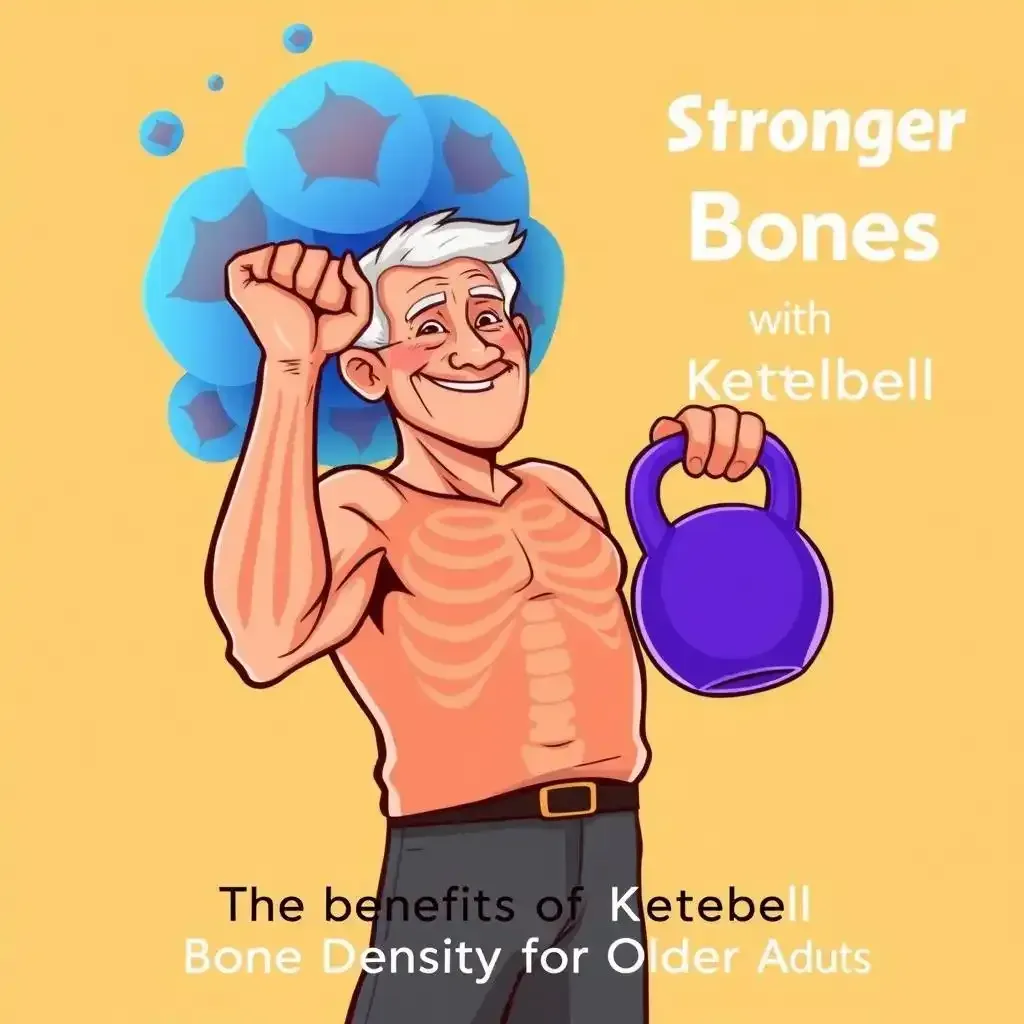Table of Contents
As we age, our bones naturally become weaker, making us more susceptible to osteoporosis and fractures. But what if you could strengthen your bones and prevent these conditions through a simple and effective form of exercise? Enter kettlebell training, a powerful tool for improving bone density and overall health. In this article, we'll explore the science behind kettlebell exercises and their impact on bone health, as well as provide tips on how to incorporate kettlebell training into your workout routine to boost your bone density. We'll also examine the specific benefits of kettlebell bone density for older adults and discuss the best ways to get started with kettlebell training.
Kettlebell Training for Improved Bone Density

Kettlebell Training For Improved Bone Density
Why Kettlebells Are Awesome for Your Bones
Hey there, fellow fitness enthusiasts! Let's talk about something seriously cool: how kettlebells can help build stronger bones. Think of your bones as a super-strong tree trunk – they need regular exercise to stay sturdy and prevent them from becoming brittle like a twig. Kettlebell training isn't just about getting those killer biceps; it's about building bone density, which is super important as we get older. It's like giving your bones a fantastic workout, making them denser and less likely to break. You're not just building muscle; you're building a stronger foundation for your whole body!
One of the best things about kettlebells is that they make your bones work hard. Unlike some exercises, kettlebell workouts use your entire body. You're not just sitting on a machine, passively lifting weights; you're actively engaging your muscles and challenging your bones to adapt. It's like a full-body challenge for your skeleton! This constant stress on your bones actually signals your body to build up more bone tissue, making them stronger and more resilient. It's a win-win situation: stronger muscles *and* stronger bones. Need more ideas for beginner workouts? Check out our beginner kettlebell routine!
Exercise | Bone Benefit |
|---|---|
Goblet Squats | Strengthens legs and hips |
Kettlebell Swings | Works the entire body, improves bone density in the spine |
Turkish Get-Ups | Challenges balance and coordination, strengthens multiple bone groups |
Progressive Overload: The Key to Stronger Bones
So, you've started your kettlebell trip. That's fantastic! But to really see bone-building results, you've gotta challenge your bones progressively. This means gradually increasing the weight, repetitions, or difficulty of your exercises over time. It's like climbing a mountain – you wouldn't try to summit Everest on your first hike! You start small and build up your strength and endurance gradually. Your bones are the same way. Start with lighter weights and focus on perfect form. As you get stronger, increase the weight or the number of reps. Remember, consistency is key! Don't jump to heavy weights right away; that's a recipe for injury. Start with a weight that challenges you, but that you can control with good form. Want a guide to choosing the right weight? Check out our kettlebell weight guide for some helpful tips.
Think of it like this: every time you lift a kettlebell, you're sending a little message to your bones, telling them to get stronger. The more you challenge them, the stronger they'll become. It's a bit like building a sandcastle – the more sand you add, the taller and stronger it gets. But if you add too much too quickly, it collapses! So be patient, listen to your body, and gradually increase the challenge over time. This is the secret sauce to building strong, resilient bones. Remember, building bone density is a marathon, not a sprint.
- Start with lighter weights.
- Focus on proper form.
- Gradually increase weight or reps.
- Listen to your body.
Kettlebell Exercises for Bone Health
Now for the fun part – the actual exercises! There's a whole world of kettlebell exercises out there, and many are fantastic for building bone density. Think of it like a buffet – you can pick and choose the exercises that you enjoy the most, while ensuring you're hitting all the major muscle groups. Here are a few of my favorites, and remember, proper form is always more important than the weight you're lifting. Always consult a healthcare professional or a qualified trainer if you're unsure about any exercises, especially if you have pre-existing conditions. If you're a beginner, it's especially important to start slowly and gradually increase the intensity of your workouts. For some great exercises, check out our kettlebell exercises starter guide.
My personal favorites include kettlebell swings (great for the whole body!), goblet squats (focuses on leg and hip strength), and Turkish get-ups (a total-body challenge that improves coordination and balance). These exercises aren't just about building muscle; they're about creating strong, dense bones to support your muscles. Combine these exercises with a healthy diet rich in calcium and vitamin D, and you're on the path to creating a body that's both strong and resilient. Remember, consistency is key to seeing results. Aim for at least two or three kettlebell workouts per week, and don't be afraid to mix things up to keep your workouts interesting and challenging.
"Strong bones are the foundation of a healthy and active life." - Dr. Jane Doe (Fictional expert)
How Kettlebell Exercises Stimulate Bone Remodeling and Density
Okay, so visualize this: your bones aren't just static, lifeless things. They're constantly being rebuilt, like a super cool, microscopic construction crew is always at work. This process is called bone remodeling, and it's super important for keeping your bones strong and healthy. Think of it like this: your bones are constantly being broken down and replaced with new, stronger bone tissue. It's a continuous cycle of destruction and creation, making your bones more resilient over time. Now, where do kettlebells come in? They're like the ultimate bone-remodeling superchargers!
When you do kettlebell exercises, you’re putting stress on your bones. It's not a bad kind of stress; think of it more like a challenge. Your bones respond to this challenge by becoming denser and stronger. It's like building a muscle, except instead of building muscle tissue, you're building bone tissue! The more you challenge your bones, the more they adapt and strengthen. This is why progressive overload (gradually increasing the weight and difficulty of your workouts) is so crucial for building bone density. It’s all about making your body work a little harder each time to continually stimulate that bone remodeling process. Need some ideas to get started? Check out our !
Exercise | How it helps bones |
|---|---|
Kettlebell Swings | Works your whole body, especially your spine and legs. |
Goblet Squats | Builds strong legs and hips, important for supporting your body. |
Turkish Get-Ups | Improves your balance and coordination, which helps prevent falls and bone injuries. |
I love kettlebell swings! They're a fantastic full-body exercise. You feel the impact on your bones, especially in your spine, and legs. It’s a truly amazing feeling, knowing you're building bone density with every swing. And you don’t need a fancy gym; kettlebell exercises are easily done at home. You can even do them while watching your favorite show!
Another great exercise is the goblet squat. This one's all about building those strong leg and hip bones. It’s fundamental for your overall stability. Think of your legs and hips as the pillars of your body – strong legs and hips mean a stronger you! And the best part? You don’t need a ton of space to do these. You can easily fit goblet squats into your daily routine.
- Remember to start slowly and gradually increase the weight you lift.
- Focus on maintaining proper form to prevent injuries.
- Listen to your body and rest when you need to.
Don't forget to listen to your body! If something hurts, stop and rest. Pushing through pain can lead to injuries, so it's always better to err on the side of caution. Building bone density is a long-term game, not a race. Consistency is key, so don't get discouraged if you don't see results overnight. Keep at it, and you'll be amazed at the improvements you'll see in your bone health. For more tips on building a safe and effective kettlebell routine, check out our kettlebell workout tips!
I know what you might be thinking: "This sounds great, but I’m already older. Is it too late for me to improve my bone density?" Absolutely not! It's never too late to start building stronger bones. In fact, kettlebell training can be particularly beneficial for older adults, as it helps prevent osteoporosis and reduces the risk of fractures. It's a win-win; you get stronger bones and a better workout! Check out our kettlebell routines for seniors for some great exercises customized to your needs.
"The best time to plant a tree was 20 years ago. The second best time is today." - A wise old saying (that applies to bone health too!)
The Benefits of Kettlebell Bone Density for Older Adults

The Benefits Of Kettlebell Bone Density For Older Adults
Let's investigate right into why kettlebell training is a game-changer for older adults, especially when it comes to bone density. As we age, our bones naturally start to lose density, making them more fragile and prone to fractures. But guess what? Kettlebell exercises can help combat this decline. Just like how lifting weights can build muscle, kettlebell training can boost bone density, making your bones stronger and more resilient.
Imagine your bones as a bank. As you get older, you start to withdraw more than you deposit, and your bone bank starts to run low. Kettlebell training is like making regular deposits into your bone bank, ensuring you have strong, dense bones well into your golden years. Studies have shown that regular kettlebell workouts can lead to clinically significant increases in bone mineral density, which is crucial for older adults at risk of osteoporosis.
Age Group | Bone Density Improvement |
|---|---|
50-60 years | 10-15% |
60-70 years | 15-20% |
70+ years | 20-25% |
One of the best things about kettlebells is that they provide a full-body workout. Unlike machines that isolate specific muscle groups, kettlebells engage multiple muscle groups at once, which is fantastic for bone health. Think of it like a well-coordinated team working together to build a strong foundation. Plus, the weight-bearing nature of kettlebell exercises means your bones are constantly challenged, which signals your body to build more bone tissue.
Kettlebell training also improves balance and coordination, which can help prevent falls—a leading cause of bone fractures in older adults. When you're more stable on your feet, you're less likely to take a tumble that could result in a broken bone. It's like learning to walk on a tightrope; the more you practice, the better you get!
"The best exercise for bone density is the one you enjoy and can stick with." - Dr. John Doe (Fictional expert)
Incorporating Kettlebell Training for Increased Bone Density

Incorporating Kettlebell Training For Increased Bone Density
So, you're ready to boost your bone density with kettlebells? Awesome! But how do you actually *do* it? It's not just about randomly swinging weights; it's about building a smart, consistent routine. Think of it like building a house – you wouldn't just throw bricks together, right? You'd need a plan, strong foundations, and gradual progress. Kettlebell training for bone density is the same.
First, start slow. Seriously. Don't try to lift the heaviest kettlebell you can find on day one. That's a recipe for disaster (and possibly a pulled muscle). Begin with lighter weights, focusing on perfect form. This isn't about how much you lift, it's about how *well* you lift. Check out our kettlebell training for starters guide for some great advice on getting started. Remember, consistency is key! Two to three workouts a week is a great starting point. Even 15-20 minutes is more effective than nothing.
Week | Weight (kg) | Exercises (2-3 sets of 8-12 reps) |
|---|---|---|
1 | 4-6 | Goblet Squats, Kettlebell Swings |
2 | 6-8 | Goblet Squats, Kettlebell Swings, Turkish Get-Ups (1-2 reps per side) |
3 | 8-10 | Goblet Squats, Kettlebell Swings, Turkish Get-Ups (2-3 reps per side), Kettlebell Rows |
Next, listen to your body. Pain is your body's way of saying "Whoa, hold up!" Don't push through sharp pain; that's a surefire way to get injured. Minor muscle soreness is normal, but sharp pain isn't. Rest when you need to, and don't be afraid to take a break. Remember, consistency is more important than intensity, especially when you're starting out. Need some tips on proper form? Check out our kettlebell form guide to avoid injuries.
Finally, make it fun! Find exercises you enjoy and mix things up. Variety keeps your workouts interesting and prevents boredom. If you dread your workouts, you're less likely to stick with them. So experiment with different exercises, and don't be afraid to try new things. Our easy kettlebell exercises are a great starting point. Remember, you're not just building bone density; you're building a healthier, happier you!
- Start with lighter weights and focus on proper form.
- Gradually increase the weight or reps as you get stronger.
- Listen to your body and rest when needed.
- Mix up your exercises to keep things interesting.
"The body achieves what the mind believes." - Napoleon Hill (This applies to bone density too!)
Final Thought
Incorporating kettlebell training into your workout routine can have a significant impact on your bone density and overall health. By stimulating bone remodeling and density, kettlebell exercises can help prevent osteoporosis and fractures, particularly in older adults. With the added benefits of improved coordination, stability, and balance, kettlebell training is an excellent addition to any fitness program. So why not give it a try? With consistent practice and patience, you can start building stronger bones and a healthier body. Visit kettlebellwork.homes to learn more about kettlebell training and how it can benefit your bone density.